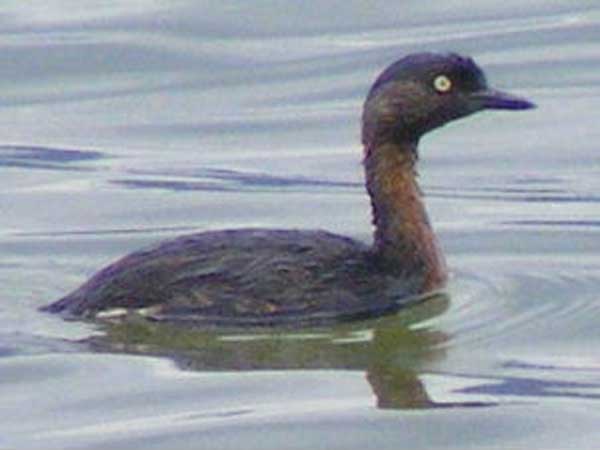
Poliocephalus rufopectus (*)
Superregnum: Eukaryota
Cladus: Unikonta
Cladus: Opisthokonta
Cladus: Holozoa
Regnum: Animalia
Subregnum: Eumetazoa
Cladus: Bilateria
Cladus: Nephrozoa
Superphylum: Deuterostomia
Phylum: Chordata
Subphylum: Vertebrata
Infraphylum: Gnathostomata
Megaclassis: Osteichthyes
Cladus: Sarcopterygii
Cladus: Rhipidistia
Cladus: Tetrapodomorpha
Cladus: Eotetrapodiformes
Cladus: Elpistostegalia
Superclassis: Tetrapoda
Cladus: Reptiliomorpha
Cladus: Amniota
Classis: Reptilia
Cladus: Eureptilia
Cladus: Romeriida
Subclassis: Diapsida
Cladus: Sauria
Infraclassis: Archosauromorpha
Cladus: Crurotarsi
Divisio: Archosauria
Cladus: Avemetatarsalia
Cladus: Ornithodira
Subtaxon: Dinosauromorpha
Cladus: Dinosauriformes
Cladus: Dracohors
Cladus: Dinosauria
Ordo: Saurischia
Cladus: Eusaurischia
Subordo: Theropoda
Cladus: Neotheropoda
Cladus: Averostra
Cladus: Tetanurae
Cladus: Avetheropoda
Cladus: Coelurosauria
Cladus: Tyrannoraptora
Cladus: Maniraptoromorpha
Cladus: Maniraptoriformes
Cladus: Maniraptora
Cladus: Pennaraptora
Cladus: Paraves
Cladus: Eumaniraptora
Cladus: Avialae
Infraclassis: Aves
Cladus: Euavialae
Cladus: Avebrevicauda
Cladus: Pygostylia
Cladus: Ornithothoraces
Cladus: Ornithuromorpha
Cladus: Carinatae
Parvclassis: Neornithes
Cohors: Neognathae
Cladus: Neoaves
Cladus: Mirandornithes
Ordo: Podicipediformes
Familia: Podicipedidae
Genus: Poliocephalus
Species: Poliocephalus rufopectus
Name
Poliocephalus rufopectus (GR Gray, 1843)
Original combination: Podiceps rufopectus
References
George Robert Gray, 1843. List of the birds hitherto recorded as found in New Zealand, Chatham and Auckland Islands. p. 198 BHL; In: Ernest Dieffenbach (ed) Travels in New Zealand; with contributions to the geography, geology, botany, and natural history of that country.; Title page: BHL
IUCN: Poliocephalus rufopectus (Near Threatened)
Vernacular names
български: Новозеландски гмурец
brezhoneg: Plomer Zeland-Nevez
Cymraeg: Gwyach Seland Newydd
English: New Zealand grebe
Esperanto: Novzelanda grebo
español: Zampullín maorí
فارسی: کشیم نیوزیلند
suomi: Uudenseelanninuikku
français: Grèbe de Nouvelle-Zélande
magyar: Maori vöcsök
Nederlands: Nieuwzeelandfuut
norsk nynorsk: Maoridukkar
norsk: Maoridykker
polski: Perkoz maoryski
پنجابی: نیوزیلینڈ ڈبکنی
русский: Новозеландская поганка
svenska: maoridopping
The New Zealand grebe, New Zealand dabchick, or weweia (Poliocephalus rufopectus) is a member of the grebe family endemic to New Zealand.
Description
The New Zealand grebe has dark brown plumage, a small black head with fine silver feathers, a black pointed bill and characteristic yellow eyes.[2][3] It grows to about 29 cm, and weigh about 250 g.[4] Non-breeding individuals have a paler plumage and females tend to be a bit lighter, smaller and have a slightly shorter bill than males.[2][5]
Adult photographed at Western Springs in Auckland
Distribution and habitat
This grebe species inhabits mainly shallow freshwater lakes, ponds and sheltered inlets.[3] Currently it is found mainly in the North Island, where it is well distributed on the coastal lakes of the West coast from North Cape to Pukekohe and from Taranaki to Paraparaumu, as well as on ponds of the Volcanic Plateau, Gisborne, Hawkes bay and the Wairarapa.[2][4][6] Formerly this species was also present in the lowland lakes of the South Island,[7] but underwent a rapid decline, for unknown reasons, in the 19th century - the last regular breeding record in the South Island was in 1941.[4] In 2012 a pair bred near Takaka for the first time in recent history.[1]
Behaviour
These freshwater diving birds usually fly only at night, whilst during the day, they are always found in the water, swimming on the surface and frequently diving to feed. Thus, if they are in danger or get disturbed at daytime they do not flee by flying, but swimming or diving away. During autumn and winter, they are found forming flocks, while during the breeding season they are mostly seen in monogamous pairs. They show aggressive territorial behaviour towards intruders [2][3] and the otherwise silent species give short calls throughout the breeding season and when in danger.[3][8]
Diet
Their diet consists mostly of aquatic insects and their larvae, as well as small molluscs such as freshwater snails.[7] Bigger prey such as fish and freshwater crayfish are sometimes eaten too.[4] Thus, their bill, being short and pointed, is adapted to their mainly invertebrate diet. They catch their prey during dives and feeding underwater or pick it from the water surface.[2][3]
Breeding
The breeding season is from June to March. On average 2-3 eggs are laid and incubated 22–23 days by both female and male, in a nest. The nest is mostly made out of surrounding vegetation, including floating plant material. Hatched chicks are precocial, although being flightless for the first few weeks they can swim and dive.[2] Both parents assist in rearing and feeding their young for up to 70 days after hatching. Until the adult plumage develops, the chick has irregular striped markings on head and neck and the bill is black.[3]
Conservation
This species is endemic to New Zealand and is nowadays only found in the North Island. In 1994, the IUCN classified the New Zealand grebe as Endangered, but due to conservation actions including habitat management, its population has recently increased to around 1,900-2,000 birds and was reclassified as Near Threatened in 2016.[1] Human activity currently has a net benefit as artificial habitat, including farm dams and ponds formed for stock water supplies, increases the area of occupation for the grebes.[2][3] So, although the population is still quite small it is thought not to be in decline anymore.[9]
References
BirdLife International (2016). "Poliocephalus rufopectus". IUCN Red List of Threatened Species. 2016: e.T22696592A93572730. doi:10.2305/IUCN.UK.2016-3.RLTS.T22696592A93572730.en. Retrieved 13 November 2021.
Robertson, Hugh; Heather, Barrie (1999). The Hand Guide to the Birds of New Zealand. Penguin.
"New Zealand dabchick". New Zealand Birds Online. Retrieved 12 April 2017.
Barrie Heather and Hugh Robertson, "The Field Guide to the Birds of New Zealand (revised edition)", Viking, 2005
Marchant, S.; Higgins, P.J. (Eds.) (1990). Handbook of Australian, New Zealand & Antarctic Birds. Volume 1, Ratites to ducks; Part A, Ratites to petrels. Melbourne: Oxford University Press. p. 107.
commoncopper (April 2022). "New Zealand Dabchick (Poliocephalus rufopectus)". iNaturalist NZ. Retrieved 2022-04-22.
Andrew Crowe, "Which New Zealand Bird?", Penguin, 2001
Chambers, S. (2009). Birds of New Zealand - Locality Guide (3rd ed.). Orewa, New Zealand: Arun Books.
"New Zealand Grebe (Poliocephalus rufopectus) - BirdLife species factsheet". datazone.birdlife.org. Retrieved 12 April 2017.
Retrieved from "http://en.wikipedia.org/"
All text is available under the terms of the GNU Free Documentation License

